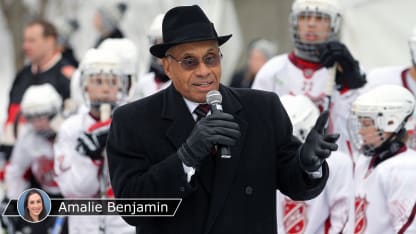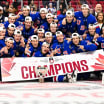MILTON, Mass. --Rows of kids looked up at the man standing in front of them. They were all young, all wearing hockey gear, many of their hands in the air, waving, waiting to be called upon. They were boys and girls, from Boston and Philadelphia, black and white. Willie O'Ree was answering their questions, silly and profound, teaching them a little bit of what it was like to be him, now and back on Jan. 18, 1958, when he became the first black player to play in the NHL.
It has been 46 years since the death of Jackie Robinson, the first black player in Major League Baseball. He has become, in some ways, more of a symbol than a real-life figure, hard to relate to for kids born well more than a quarter century after his death.
O'Ree making impact 60 years after breaking NHL color barrier
First black player in League living example of how game is open to everyone

© Getty Images
But O'Ree is here at Ulin Memorial Rink in Milton, Massachusetts, talking to them in his role as the League's Director of Youth Development, explaining what it was to be the one black face in a sea of white faces, quizzing them on the Original Six teams, living history in the midst of a league that now features black stars such as P.K. Subban, Seth Jones and Wayne Simmonds.
It was 60 years ago this week when O'Ree got the call from the Boston Bruins, notifying him that they would like to bring him up for a pair of games against the Montreal Canadiens, the first on Jan. 18 at the Montreal Forum, a place that O'Ree had played in multiple times.
But never like this.
"I took the train up to Montreal, met the team, met Milt Schmidt the coach, and we sat down," said O'Ree, now 82 years old. "He said, 'Willie, we brought you up because you could add a little something to the team.' He said, 'Don't worry about anything else. The Bruins organization is behind you 100 percent. Just go out and play your game.'"
O'Ree did. He played the game he grew up playing and loving, obsessing over it as the youngest of 13 children growing up in Fredricton, New Brunswick. He started dreaming of playing hockey professionally at 14, but it wasn't until later that the NHL had entered his mind, not until after multiple coaches told him he had the skill and talent to move up to the highest ranks, though, they warned, there had never been a black player. Not yet.
"I was thrilled," said O'Ree, who added that he didn't think about breaking the color barrier until he read about it in the newspaper the next day. "I had played against the Montreal Canadiens in exhibition games. They played in the Forum. I had played against the Montreal Junior Canadiens in the Forum. I played against the pro team in Montreal, the Montreal Royals, in the Forum.
"But now I'm skating on the ice with the Boston Bruins and playing in a National Hockey League game in the Montreal Forum and it was great. It was a big thrill for me. And I'll never forget it. It was like it happened yesterday."
O'Ree, who will be honored before the Bruins play the Canadiens at TD Garden in Boston on Wednesday (7:30 p.m. ET; NBCSN, SN, RDS, NHL.TV), fell in love with the Bruins organization in 1957, when he joined the team for training camp, meeting the players and getting to know them. That helped, he said, when he joined them in the middle of the regular season for his barrier-shattering two games.
They welcomed him. They looked out for him.
"It was just like a family-type thing," O'Ree said. "On the road, they would watch my back because there were certain players on the opposition that didn't like me because of my color, but I just went out and played hockey and tried to represent the hockey club the best I could."
Because for all O'Ree's good memories, there were also a few bad. There were a few altercations with visiting teams, something that he expected. His older brother Richard, who got him into hockey when he was 5 years old, taught him about body checking, how to give and take checks, how to protect himself. He had prepared O'Ree for what might be coming.
What mattered more, though, was the support of those teammates.
"They knew the type of hockey player I was," he said. "They knew I was an aggressive hockey player. I fit in with their program and I just went out and played and forgot about everything else that was going on. All I wanted to do was play hockey and be the best hockey player I could for the team."
He played a second game, back in Boston, this one a loss to the Canadiens, before the Bruins returned him to the Quebec Aces. He was back with the Bruins in 1960-61, when he had 14 points (four goals, 10 assists) in 43 games.
It could have been more, almost certainly would have been more, except for one thing: O'Ree was playing without the sight in his right eye. He lost 97 percent of his sight when a puck ricocheted and hit him, shattering his retina when he was 19 years old. He told two people -- his sister and a friend -- and no one on the hockey teams he played on, no one on the Bruins and not even his parents, who died not knowing their son made it to the NHL without being able to see out of his right eye.
O'Ree played professionally for 21 years, on teams from Quebec to Los Angeles to New Haven, Connecticut, to San Diego, but no game was bigger than the one he played Jan. 18, 1958, when he became the NHL's answer to Robinson.
O'Ree first met Robinson in 1949, when he was 14 years old and playing both baseball and hockey. By 1962, when he met Robinson again, he had settled on hockey, and the two briefly chatted about their shared accomplishment. They had integrated their sports, created change.
"He understood he was representing something bigger than himself," said New Jersey Devils radio analyst Glenn "Chico" Resch, who played with O'Ree for New Haven of the American Hockey League in 1972-73. "He was conscious of the League. He was conscious of who he was."
And who he is now, someone who paved the way for the 85 other black players in the NHL since his debut, including the 24 to play in the League this season, and the countless others in underrepresented groups who would not have played hockey but for O'Ree's influence. He's someone who is welcoming in the stars of tomorrow in his job with the NHL Diversity Program, which he prizes.
"They're there because they have the skills and the ability to be there," O'Ree said of Subban, Simmonds, Jones and former black players like Jarome Iginla, who played 19 seasons in the League. "They're not just there because they're players of color. They're there because they have great talent and great skill. You can see it the way they play. I enjoy watching them play, I really do. Every time I see one of them on the ice I can just flash back."
To what he did Jan. 18, 1958, 60 years ago, a day that had an impact then, and one that continues to have an impact today.

















